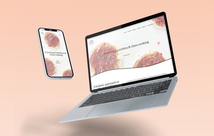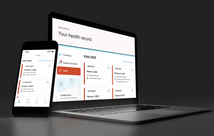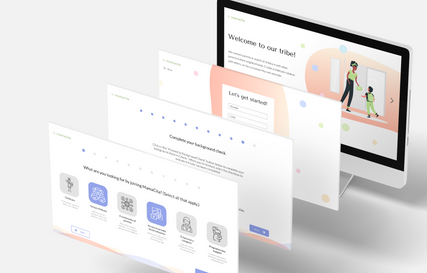
K E E Z Y K L A S S
THE CONTEXT
My team was tasked with understanding the Keezy Classic app and its offerings to build a new app that aligns with Keezy’s products and services.
THE GOAL
Our goal was to incorporate the Keezy sound board into a learning environment that works to best serve different learning styles.
We created a user-centered music learning app in a 2 week timeline.
MY ROLE
I operated as the UX researcher and UI designer throughout this project producing deliverables such as personas, lo-fi prototypes, and clickable prototypes.
OUR PROCESS
Our process consisted of discover and design phases, within which we conducted research, both user and competitive, then analysis, and synthesis of our problem. We next began the develop and deliver phases within which we focussed on sketching, prototyping and iterating those prototypes.

RESEARCH
USER INTERVIEWS
We conducted 13 user interviews, 9 women and 4 men within the age range of 23 to 53. All interviewees were music listeners, and two of those interviewees are musicians, one vocal and one pianist.

During these interviews we asked several questions some of which are listed below:
-
Could you tell me about your relationship with music? How do you enjoy it? (i.e. creating, learning, listening, sharing)
-
What apps do you use to share/create/listen/learn music?
-
What capabilities on those apps have you used the most in the last day?
-
When you’re learning a new skill on your own, what is the first thing you do?
-
When do you feel frustrated while learning something new?
-
How do you get re-engaged with a skill you were once trying to learn but stopped?
These questions gave us key insights.
SYNTHESIS
AFFINITY MAPPING
We then conducted affinity mapping in order to further determine any other trends and issues that could be addressed by our solution. Among these answers, learning methods fell into two buckets: learning by trial & error or learning by example. 5 participants also noted being re-engaged in learning a skill when a community component has been involved.


PERSONAS
Next, we created 2 personas to synthesize and focus on our problems in preparation for designing prototypes.
We then performed secondary research on educational apps and services.
Quizlet and Duolingo are both services used for educational purposes. These services demonstrate what the wrong answer was only, rather than demonstrate what exactly went wrong. These services don’t include videos that demonstrate a skill or correct course of action before the student attempts the skill.
Quizlet focusses on the student having the information prior to using the app and inputting that information themselves. Duolingo is an app that teaches language rather than a skill that is physically performed.
SECONDARY RESEARCH
From these personas, affinity mapping, and competitive research, we identified the problem and our design solution.
THE PROBLEM
Learning music concepts within an app requires an understanding of as well as demonstrations of the concepts learned. Learning apps generally don’t focus on correcting mistakes which, as noted by the interviewees, is a fundamental aspect of their learning as well as having a community to encourage and compete.
THE SOLUTION
Adding a feature that focuses on both first showing the expected outcome, as well as giving an explanation for missteps, helps users learn. Including a community portion of the app as well will allow for healthy competition and community.
DESIGN
First, we focussed on creating the user flows for signing up for Keezy. Then, we created the flows for choosing lessons and lastly for actual game play.

We then began sketching out the most important features of the app including the level introduction video format, the lesson play mode screen and the incorrect play explanation screen. We included annotations here as well as received some initial feedback in user tests.

PAPER PROTOTYPES
Next, we created a paper prototype to conduct further usability tests. We received some great feedback.
Most significant was the note that the app needed to show a clearer indication of when the sounds were being played and having each square include a clear indication that it had been selected.

After receiving this feedback, we finally moved into the creating a digital clickable prototype using Balsamiq. Below are the screens for this prototype. If you'd like to see the full version of the prototype, please contact me!
Although this was the stopping point for the purposes of my General Assembly course - I came back to the project to continue iteration and increase the fidelity of this prototype to hi-fi.
NEXT STEPS
HIGHLIGHTS
-
Tools: User Interviews, Affinity Mapping, Personas, User Flows, Sketches, Paper Prototypes, Usability Testing, Balsamiq (lo-fi & hi-fi clickable prototypes)
-
Synopsis: Conceptualized an alternate path for reviving use of Keezy Classic's app by shifting their mission towards user's music education and designed a hi-fi prototype utilizing the entire design thinking process. This process allowed me to further explore working creatively within an already established brand identity in the app's user interface.
-
Timeline: 1 week sprint
-
Role & Team: Acted as the UX Researcher and UI Designer and worked alone.
-
Looking forward, fleshing out steps for beginners should be a first priority to allow for an interactive tutorial and further support those who learn by mimicking others motions.
-
In addition, another priority should be creating separation between learning music concepts & composition where users first learn concepts and then use those concepts within their compositions to demonstrate their understanding.
-
Lastly, we’d like to further the community functionality where users are able to challenge others to encourage a dedication and motivation to learn.
"Usually, I keep trying something until I get it right but I get frustrated if it takes too long to master."
"Definitely watch videos on Youtube to learn something first, like when I was trying to learn to make bread."
"Basically just learn by example, mimicking other people's movements. When I learned to play piano, I learned my teacher's keystrokes."























